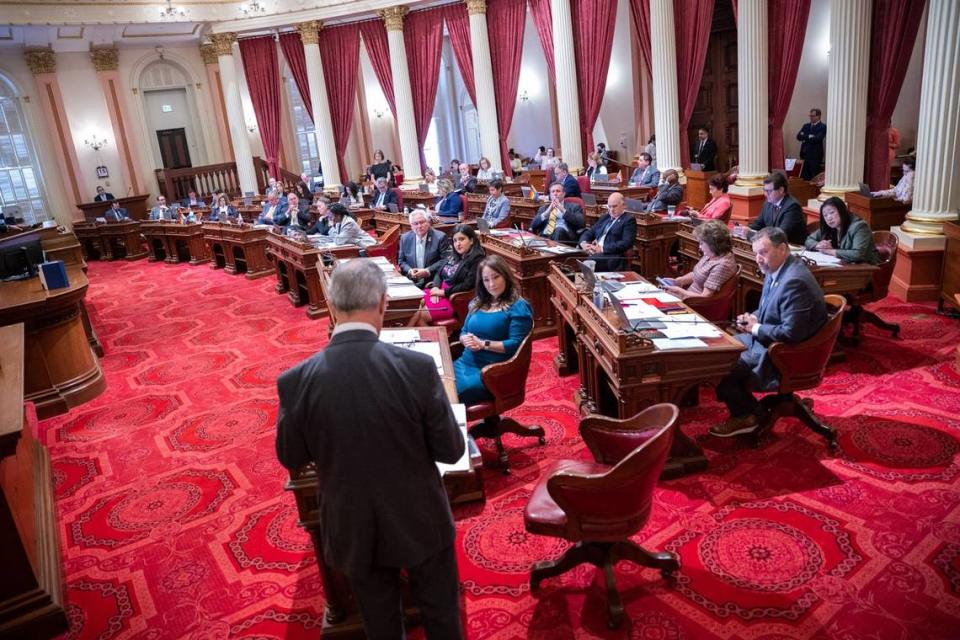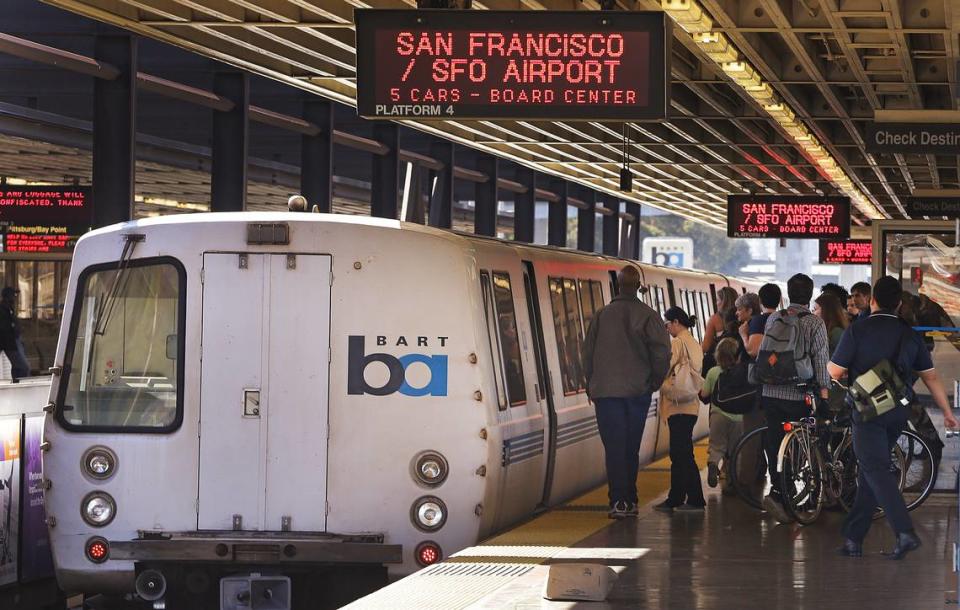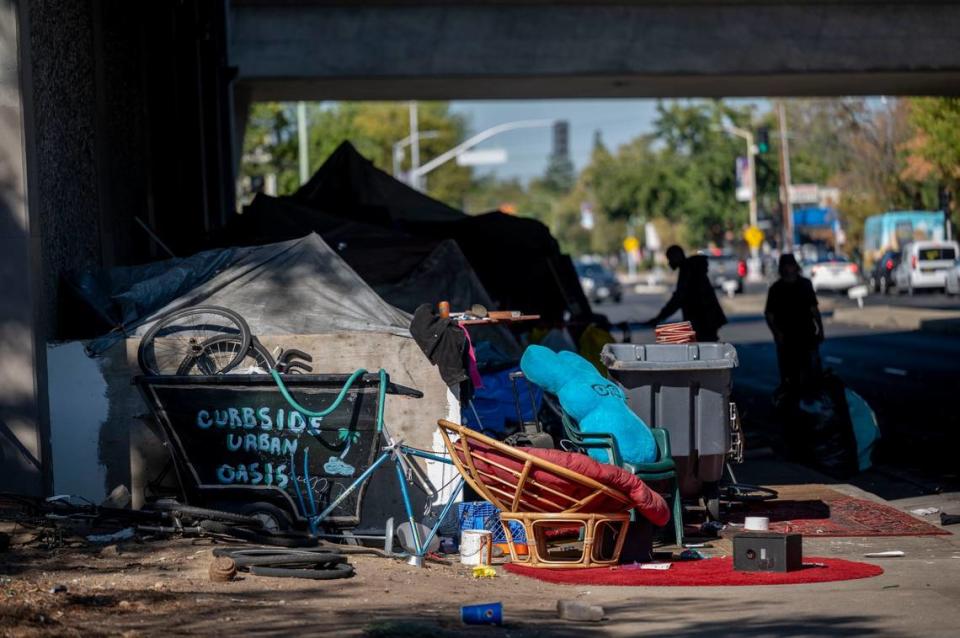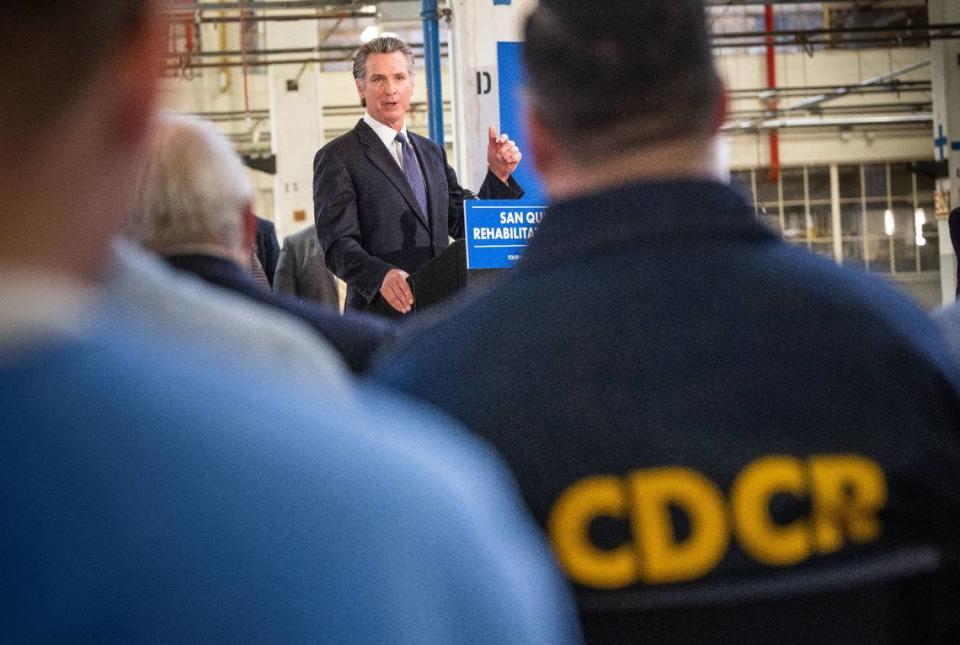Gavin Newsom, California lawmakers face looming budget deadline. Here’s what they’re debating
- Oops!Something went wrong.Please try again later.
California Gov. Gavin Newsom and Democratic legislative leaders have negotiated major elements of the state budget — although they remain at odds over Newsom’s eleventh-hour push to streamline large-scale infrastructure projects.
On Saturday and Sunday, lawmakers released bills showing the major outlines of a $310.8 billion spending plan that eliminates proposed cuts to public transit, funds a plan to transform San Quentin State Prison and increases pay for child care providers.
But Newsom and Senate and Assembly leaders still had yet to announce a final agreement by Sunday night, even after a weekend of negotiations. The governor has until Tuesday to sign, veto or veto parts of the budget bill lawmakers approved on June 15.
Lawmakers could take a bit longer on other bills related to the budget, but a new fiscal year begins on June 30. That means this week is crunch time for working out the state’s spending plan.
The primary budget sticking point has been a series of proposals from the governor to fast-track certain water, transportation and clean energy infrastructure projects under changes to the California Environmental Quality Act.
Newsom claims the CEQA reforms are necessary to stem delays that come with the state’s stringent environmental regulations.
Legislators have accused Newsom of trying to use the budget process to force consequential policy changes.
They claim the CEQA reforms are aimed at expediting construction of a controversial 45-mile Delta tunnel that would transport water from the Sacramento River to other regions of California. Farmers and natural resource advocates say the project would hurt their water supply and negatively affect fish and other wildlife in the area.
Assemblyman Carlos Villapudua, D-Stockton, on Thursday called the infrastructure proposals and the tunnel “the elephant on the table.”
“At the end of the day, the body will speak,” Villapudua said. “Both the Assembly, both the Senate. And the governor’s going to have to accept this.”

Budget haggling
Newsom and legislative leaders have been working out how to close the state’s projected $31.5 billion shortfall — a predicament the governor and Sacramento lawmakers were able to avoid the past two years.
The state Senate and Assembly budget committees are set to discuss bills on Monday, followed by a full vote at the Capitol later in the week.
California leaders must fix a budget gap largely caused by a progressive income tax structure that makes the state susceptible to revenue swings. When its wealthiest residents are flourishing — like they did during the first two years of the COVID-19 pandemic — so are the state’s finances. The state had unprecedented budget surpluses during the past two fiscal years.
But the opposite is the case when those same Californians experience reversals of fortune. A post-pandemic economy with rising interest rates and a slumping stock market has taken a toll on the state’s tax revenue and forced leaders to make tough budget decisions.
Newsom announced his revised budget in May, and the Legislature approved their own version of the spending plan ahead of a constitutional deadline on June 15. Lawmakers’ budget served as a placeholder while leaders negotiated with the governor.

Transit funding
Some interest groups were more successful in securing funds than others. Newsom and lawmakers also struck compromises on several issues.
Transit agencies prevailed in their mission to fend off $2 billion in cuts to transit capital projects proposed by the governor.
The preliminary spending plan not only reverses the possible cuts Newsom floated in January but also provides transit agencies with flexibility to shift certain funds to cover operating expenses.
It comes after the state’s largest transit agencies pleaded for additional funding to maintain their service levels. Bay Area Rapid Transit, or BART, and Los Angeles Metro said they were on the verge of cutting bus lines and reducing hours due to lagging fare box revenue and dwindling federal assistance.
The governor yielded to vehement opposition by transit advocates and California lawmakers — but with strings attached. Newsom has requested additional accountability guidelines to ensure the dollars spent are resulting in more people opting for trains and buses over cars.

Child care and homelessness
Child Care Providers United — a labor union that represents more than 40,000 in-home workers — was able to wrest fee reductions for low income families and money to supplement reimbursement rates, subject to ongoing collective bargaining.
Union members care for children from low-income families who partially pay for their services with subsidies. They gained the ability to collectively bargain with the state in 2019, and the contract they signed in 2021 expires on June 30.
A push from California cities and counties to lock in an extra $1 billion for local homeless initiatives was not as fruitful.
The budget allocated $1 billion in one-time funding for a fifth round of grants through the Homeless Housing, Assistance and Prevention program, also known as HHAP. That was the same amount Newsom originally proposed.
But the spending plan noticeably leaves out a request from Democrats to guarantee an additional $1 billion for a sixth round of HHAP funding. Instead, it contains “intent language” promising support for additional grant money.
Lawmakers and local elected officials argued that the added funding would help them pursue longer-term solutions to the homeless crisis. Newsom has been reluctant to provide anything close to ongoing homeless funding because he says the money is dependent on results and accountability for local agencies.
Like the transit funding, the governor wants to ensure that the dollars spent by the state are leading to a decline in the number of people living on the streets.

Prison closures and San Quentin reforms
Newsom achieved a budget victory that will allow him to carry out a proposal to reform San Quentin State Prison. During his State of the State tour in March, the governor announced plans to turn the facility into a Scandinavian-style rehabilitation center.
He wanted more than $380 million to make it happen, but skeptical legislators proposed giving Newsom only $20 million to cover planning costs.
The negotiated spending plan contains the full amount the governor requested.
The budget does not contain language requiring five additional prison closures by 2027, a proposal Assembly leaders put forward.
But lawmakers will require Newsom’s administration to produce assessments of state prison operating and housing needs to inform future decisions about closures.

